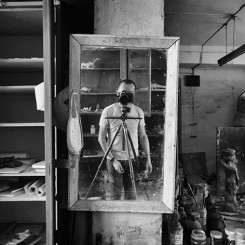These photos hone in on the aesthetics of the era as conveyed by the work of the museum’s idealistic and conscientious staff. Yet the artist’s aesthetic decisions play a large part in many other photographs. While the documentary-styled photos pay no attention to the reflections in the glass cabinets, Feng’s more aesthetically considered photos deliberately utilize these reflections to create effects specific to the museum’s environment. This device is used to great effect in his black-and-white photographs where the reflections cause almost hallucinogenic images such as “Panda No. 1″ (2012), in which taxidermy pandas and bamboo are intermingled with the reflections of museum windows and other display cases to create a seemingly multi-exposed yet coherent image. This mixture of documentary and aesthetic serves to engage the viewer with the museum on different levels. If this show was made from either a purely documentary or aesthetic perspective, it would serve to identify only with the museum or the artist. Instead, Feng Mengbo wants viewers to identity with the museum and the artist. In other words, the artist wants to be identified with the museum. This reveals a personal connection with Shanghai Natural History Museum beyond that of professional or aesthetic interest, and this is the motive behind the show’s rather confessional title, “My Private Museum.”
Although the medium used by Feng Mengbo is a departure from his former computer-based work, the personal nature of this show is a long-delayed continuation of a series of early works titled My Private Album that traced the past three generations of Feng’s family. Starting with a set of engravings in the late 1980s, it was followed in 1991–92 with an installation using handmade paper and netting, and finally culminating in 1996 with an interactive CD-ROM work that combined digitized old photographs of his family mixed in with memorabilia from the socialist era. The latter work launched his career on the international stage. By then, his passion had switched from personal narratives to the potential of digital technology, and he hasn’t looked back since. That is, until this show. The Shanghai Natural History Museum seems to have rekindled in Feng the need to trace his past, in this case the experience of visiting museums as a child. It is perhaps ironic in Feng Mengbo’s case that newer museums do not function for him because of their more technological approach to public education — by replacing stuffed animals with interactive screens. This museum has received no facelift, no development, and Feng seems to have seen the innocence of his own childhood in those cabinets, having waited 30 years to be rediscovered. However, Feng just couldn’t resist including a technological twist to the show, so he created a set of lenticular prints that create a three dimensional effect for viewers. This old-fashioned 3D technology once used on everything from postcards to pencil cases that wowed kids in the 1980s might even be one of Feng’s earliest sources of inspiration for his later love for technical creativeness. The playfully nostalgic nature of these 3D works not only connect the show with Feng’s more geeky side, they add an element of humour to an otherwise straight-laced show, not allowing it to take itself too seriously. After all, for an artist that invented the dance-pad version of Quake (“a_Q,” 2002), he can only keep a straight face for so long.
